The Remains of What Appear to Be the Oldest Stone Temples Have Been Discovered in ____.
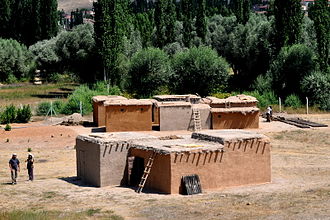 The Neolithic is characterized past fixed human settlements and the invention of agronomics from circa 10,000 BC. Reconstruction of Pre-Pottery Neolithic B housing in Aşıklı Höyük, modern Turkey. | |
| Flow | Final menstruation of Stone Age |
|---|---|
| Dates | 10,000–4,500 BC |
| Preceded by | Mesolithic, Epipalaeolithic |
| Followed by | Chalcolithic |

The Neolithic period is the final segmentation of the Stone Age, with a broad-ranging set of developments that announced to have arisen independently in several parts of the earth. Information technology is first seen near 12,000 years ago when the first developments of farming appeared in the Epipalaeolithic About East, and later in other parts of the world. The Neolithic lasted (in that part of the earth) until the transitional period of the Chalcolithic from nearly six,500 years ago (4500 BC), marked by the evolution of metallurgy, leading up to the Bronze Age and Iron Age.
In other places the Neolithic followed the Mesolithic and then lasted until after. In Northern Europe, the Neolithic lasted until almost 1700 BC, while in China it lasted until circa 2000 BC with the ascension of the pre-Shang Erlitou culture.[1] Other parts of the earth (including Oceania and the northern regions of the Americas) remained broadly in the Neolithic stage of development until European contact.[ii]
The Neolithic introduced the Neolithic Revolution or "Neolithic parcel", comprising a progression of behavioral and cultural characteristics and changes, above all the introduction of farming and use of domesticated animals.[a]
The term Neolithic is modernistic, based on Greek νέος néos 'new' and λίθος líthos 'stone', literally 'New Stone Age'. The term was coined by Sir John Lubbock in 1865 as a refinement of the three-age system.[three]
Origin
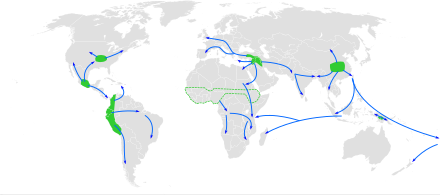
Approximate centers of origin of agriculture in the Neolithic revolution and its spread in prehistory: the Fertile Crescent (11,000 BP), the Yangtze and Xanthous River basins (ix,000 BP) and the New Republic of guinea Highlands (9,000–6,000 BP), Central Mexico (5,000–iv,000 BP), Northern South America (five,000–four,000 BP), sub-Saharan Africa (5,000–4,000 BP, exact location unknown), eastern N America (iv,000–3,000 BP).[4]
Following the ASPRO chronology, the Neolithic started in around x,200 BC in the Levant, arising from the Natufian culture, when pioneering use of wild cereals evolved into early farming. The Natufian period or "proto-Neolithic" lasted from 12,500 to ix,500 BC, and is taken to overlap with the Pre-Pottery Neolithic (PPNA) of ten,200–8800 BC. As the Natufians had get dependent on wild cereals in their nutrition, and a sedentary way of life had begun among them, the climatic changes associated with the Younger Dryas (about 10,000 BC) are idea to have forced people to develop farming.
By 10,200–eight,800 BC farming communities had arisen in the Levant and spread to Asia Modest, N Africa and North Mesopotamia. Mesopotamia is the site of the primeval developments of the Neolithic Revolution from around x,000 BC.
Early Neolithic farming was express to a narrow range of plants, both wild and domesticated, which included einkorn wheat, millet and spelt, and the keeping of dogs. By about 8000 BC, it included domesticated sheep and goats, cattle and pigs.
Non all of these cultural elements characteristic of the Neolithic appeared everywhere in the same lodge: the earliest farming societies in the Near East did non employ pottery. In other parts of the world, such equally Africa, Southern asia and Southeast Asia, independent domestication events led to their own regionally distinctive Neolithic cultures, which arose completely independently of those in Europe and Southwest Asia. Early Japanese societies and other E Asian cultures used pottery earlier developing agriculture.[5] [6]
Periods by region
Southwest Asia
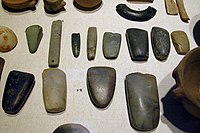
An assortment of Neolithic artifacts, including bracelets, axe heads, chisels, and polishing tools.
In the Middle East, cultures identified as Neolithic began appearing in the tenth millennium BC.[7] Early development occurred in the Levant (e.g. Pre-Pottery Neolithic A and Pre-Pottery Neolithic B) and from there spread eastwards and westwards. Neolithic cultures are also attested in southeastern Anatolia and northern Mesopotamia by around 8000 BC.[ citation needed ]
Pre-Pottery Neolithic A
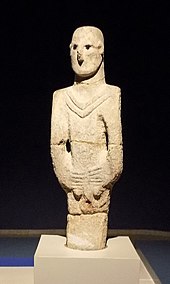
The Neolithic 1 (PPNA) catamenia began roughly around ten,000 BC in the Levant.[seven] A temple area in southeastern Turkey at Göbekli Tepe, dated to around 9500 BC, may exist regarded as the beginning of the period. This site was developed by nomadic hunter-gatherer tribes, as evidenced by the lack of permanent housing in the vicinity, and may be the oldest known human-fabricated place of worship.[11] At least seven rock circles, roofing 25 acres (x ha), incorporate limestone pillars carved with animals, insects, and birds. Rock tools were used by maybe as many every bit hundreds of people to create the pillars, which might have supported roofs. Other early on PPNA sites dating to around 9500–9000 BC have been found in Tell es-Sultan (ancient Jericho), Israel (notably Ain Mallaha, Nahal Oren, and Kfar HaHoresh), Gilgal in the Jordan Valley, and Byblos, Lebanon. The start of Neolithic one overlaps the Tahunian and Heavy Neolithic periods to some degree.[ citation needed ]
The major advance of Neolithic i was true farming. In the proto-Neolithic Natufian cultures, wild cereals were harvested, and perhaps early seed option and re-seeding occurred. The grain was ground into flour. Emmer wheat was domesticated, and animals were herded and domesticated (animate being husbandry and selective breeding).[ citation needed ]
In 2006, remains of figs were discovered in a house in Jericho dated to 9400 BC. The figs are of a mutant variety that cannot be pollinated past insects, and therefore the trees can simply reproduce from cuttings. This show suggests that figs were the first cultivated crop and mark the invention of the engineering science of farming. This occurred centuries before the starting time tillage of grains.[12]
Settlements became more permanent, with circular houses, much like those of the Natufians, with single rooms. However, these houses were for the first time made of mudbrick. The settlement had a surrounding stone wall and perhaps a stone tower (as in Jericho). The wall served as protection from nearby groups, every bit protection from floods, or to keep animals penned. Some of the enclosures also suggest grain and meat storage.[13]
Pre-Pottery Neolithic B

The Neolithic 2 (PPNB) began around 8800 BC according to the ASPRO chronology in the Levant (Jericho, West Banking concern).[7] Every bit with the PPNA dates, there are 2 versions from the aforementioned laboratories noted above. This system of terminology, however, is not convenient for southeast Anatolia and settlements of the middle Anatolia basin.[ citation needed ] A settlement of 3,000 inhabitants was found in the outskirts of Amman, Hashemite kingdom of jordan. Considered to be one of the largest prehistoric settlements in the Near East, called 'Ain Ghazal, it was continuously inhabited from approximately 7250 BC to approximately 5000 BC.[xiv]
Settlements have rectangular mud-brick houses where the family unit lived together in single or multiple rooms. Burying findings advise an ancestor cult where people preserved skulls of the expressionless, which were plastered with mud to make facial features. The rest of the corpse could have been left outside the settlement to decay until only the bones were left, then the bones were buried inside the settlement underneath the floor or between houses.[ citation needed ]
Pre-Pottery Neolithic C
Work at the site of 'Ain Ghazal in Jordan has indicated a afterward Pre-Pottery Neolithic C menstruum. Juris Zarins has proposed that a Circum Arabian Nomadic Pastoral Complex developed in the period from the climatic crisis of 6200 BC, partly every bit a consequence of an increasing emphasis in PPNB cultures upon domesticated animals, and a fusion with Harifian hunter gatherers in the Southern Levant, with affiliate connections with the cultures of Fayyum and the Eastern Desert of Egypt. Cultures practicing this lifestyle spread downwardly the Ruddy Ocean shoreline and moved e from Syria into southern Republic of iraq.[fifteen]
Belatedly Neolithic
The Belatedly Neolithic began around half dozen,400 BC in the Fertile Crescent.[vii] By then distinctive cultures emerged, with pottery similar the Halafian (Turkey, Syria, Northern Mesopotamia) and Ubaid (Southern Mesopotamia). This catamenia has been farther divided into PNA (Pottery Neolithic A) and PNB (Pottery Neolithic B) at some sites.[xvi]
The Chalcolithic (Stone-Bronze) flow began nearly 4500 BC, then the Statuary Historic period began about 3500 BC, replacing the Neolithic cultures.[ commendation needed ]
Fertile Crescent
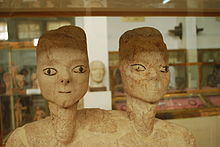
Effectually 10,000 BC the first fully developed Neolithic cultures belonging to the phase Pre-Pottery Neolithic A (PPNA) appeared in the Fertile Crescent.[seven] Around 10,700–9400 BC a settlement was established in Tell Qaramel, ten miles (16 km) n of Aleppo. The settlement included two temples dating to 9650 BC.[17] Around 9000 BC during the PPNA, one of the world's first towns, Jericho, appeared in the Levant. Information technology was surrounded by a stone wall, may take independent a population of upwardly to 2,000–3,000 people, and contained a massive stone tower.[18] Around 6400 BC the Halaf culture appeared in Syrian arab republic and Northern Mesopotamia.
In 1981, a team of researchers from the Maison de l'Orient et de la Méditerranée, including Jacques Cauvin and Oliver Aurenche, divided Near East Neolithic chronology into 10 periods (0 to 9) based on social, economic and cultural characteristics.[xix] In 2002, Danielle Stordeur and Frédéric Abbès advanced this system with a sectionalisation into five periods.
- Natufian between 12,000 and 10,200 BC,
- Khiamian betwixt 10,200 and 8800 BC, PPNA: Sultanian (Jericho), Mureybetian,
- Early PPNB (PPNB ancien) between 8800 and 7600 BC, center PPNB (PPNB moyen) betwixt 7600 and 6900 BC,
- Late PPNB (PPNB récent) between 7500 and 7000 BC,
- A PPNB (sometimes called PPNC) transitional phase (PPNB last) in which Halaf and nighttime faced burnished ware begin to sally betwixt 6900 and 6400 BC.[20]
They also advanced the idea of a transitional stage betwixt the PPNA and PPNB between 8800 and 8600 BC at sites like Jerf el Ahmar and Tell Aswad.[21]
Southern Mesopotamia
Alluvial plains (Sumer/Elam). Depression rainfall makes irrigation systems necessary. Ubaid culture from 6,900 BC.[ citation needed ]
North Africa
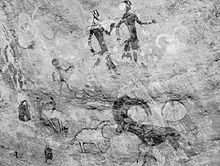
Algerian cave paintings depicting hunting scenes
Domestication of sheep and goats reached Egypt from the Well-nigh East perchance every bit early on every bit 6000 BC.[22] [23] [24] Graeme Barker states "The first indisputable evidence for domestic plants and animals in the Nile valley is not until the early fifth millennium BC in northern Arab republic of egypt and a thousand years later further southward, in both cases every bit role of strategies that however relied heavily on fishing, hunting, and the gathering of wild plants" and suggests that these subsistence changes were not due to farmers migrating from the Nigh East just was an ethnic development, with cereals either ethnic or obtained through commutation.[25] Other scholars argue that the primary stimulus for agronomics and domesticated animals (likewise as mud-brick architecture and other Neolithic cultural features) in Egypt was from the Middle E.[26] [27] [28]
Sub-Saharan Africa
The Pastoral Neolithic refers to a period in Africa's prehistory marking the beginning of food production on the continent post-obit the Later Rock Age. In contrast to the Neolithic in other parts of the world, which saw the development of farming societies, the first form of African food product was mobile pastoralism,[29] [30] or means of life centered on the herding and direction of livestock. The term "Pastoral Neolithic" is used near oft past archaeologists to describe early on pastoralist periods in the Sahara,[31] as well as in eastern Africa.[32]
The Savanna Pastoral Neolithic or SPN (formerly known as the Stone Bowl Culture) is a collection of ancient societies that appeared in the Rift Valley of East Africa and surrounding areas during a time period known as the Pastoral Neolithic. They were Southward Cushitic speaking pastoralists, who tended to bury their dead in cairns whilst their toolkit was characterized by stone bowls, pestles, grindstones and earthenware pots.[33] Through archaeology, historical linguistics and archaeogenetics, they conventionally accept been identified with the area's kickoff Afroasiatic-speaking settlers. Archaeological dating of livestock basic and burying cairns has also established the cultural complex every bit the earliest centre of pastoralism and rock construction in the region.[ citation needed ]
Europe


Map showing distribution of some of the main civilization complexes in Neolithic Europe, c. 3500 BC
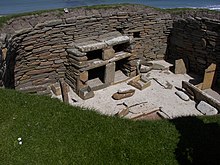
Skara Brae, Scotland. Evidence of home effects (shelves)
In southeast Europe agrarian societies starting time appeared in the 7th millennium BC, attested by one of the earliest farming sites of Europe, discovered in Vashtëmi, southeastern Albania and dating back to 6500 BC.[34] [35] In most of Western Europe in followed over the side by side two thousand years, but in some parts of Northwest Europe information technology is much later on, lasting but nether three,000 years from c. 4500 BC–1700 BC.
Anthropomorphic figurines have been institute in the Balkans from 6000 BC,[36] and in Cardinal Europe past around 5800 BC (La Hoguette). Amongst the earliest cultural complexes of this area are the Sesklo civilisation in Thessaly, which later expanded in the Balkans giving rise to Starčevo-Körös (Cris), Linearbandkeramik, and Vinča. Through a combination of cultural improvidence and migration of peoples, the Neolithic traditions spread west and northwards to reach northwestern Europe by around 4500 BC. The Vinča culture may have created the earliest system of writing, the Vinča signs, though archaeologist Shan Winn believes they well-nigh likely represented pictograms and ideograms rather than a truly developed form of writing.[37]
The Cucuteni-Trypillian culture built enormous settlements in Romania, Moldova and Ukraine from 5300 to 2300 BC. The megalithic temple complexes of Ġgantija on the Mediterranean isle of Gozo (in the Maltese archipelago) and of Mnajdra (Malta) are notable for their gigantic Neolithic structures, the oldest of which date back to around 3600 BC. The Hypogeum of Ħal-Saflieni, Paola, Malta, is a subterranean construction excavated around 2500 BC; originally a sanctuary, it became a necropolis, the but prehistoric underground temple in the globe, and shows a degree of artistry in stone sculpture unique in prehistory to the Maltese islands. Subsequently 2500 BC, these islands were depopulated for several decades until the arrival of a new influx of Bronze Age immigrants, a culture that cremated its dead and introduced smaller megalithic structures called dolmens to Malta.[38] In almost cases at that place are small chambers here, with the cover made of a large slab placed on upright stones. They are claimed to belong to a population different from that which built the previous megalithic temples. Information technology is presumed the population arrived from Sicily because of the similarity of Maltese dolmens to some small constructions constitute in that location.[39]
South and Eastern asia
Settled life, encompassing the transition from foraging to farming and pastoralism, began in Southern asia in the region of Balochistan, Pakistan, around 7,000 BC.[40] [41] [42] At the site of Mehrgarh, Balochistan, presence tin be documented of the domestication of wheat and barley, rapidly followed by that of goats, sheep, and cattle.[43] In Apr 2006, information technology was announced in the scientific journal Nature that the oldest (and kickoff early on Neolithic) show for the drilling of teeth in vivo (using bow drills and flint tips) was found in Mehrgarh.[44]
In South India, the Neolithic began by 6500 BC and lasted until around 1400 BC when the Megalithic transition period began. South Indian Neolithic is characterized by Ash mounds[ clarification needed ] from 2500 BC in Karnataka region, expanded later to Tamil Nadu.[45]
In Eastward Asia, the earliest sites include the Nanzhuangtou culture around 9500–9000 BC,[46] Pengtoushan civilisation around 7500–6100 BC, and Peiligang culture around 7000–5000 BC. The prehistoric Beifudi site near Yixian in Hebei Province, China, contains relics of a culture contemporaneous with the Cishan and Xinglongwa cultures of about 6000–5000 BC, Neolithic cultures east of the Taihang Mountains, filling in an archaeological gap between the two Northern Chinese cultures. The full excavated expanse is more than 1,200 foursquare yards (1,000 mii; 0.10 ha), and the collection of Neolithic findings at the site encompasses two phases.[47]
The 'Neolithic' (defined in this paragraph every bit using polished stone implements) remains a living tradition in small and extremely remote and inaccessible pockets of W Papua (Indonesian New Guinea). Polished stone adze and axes are used in the present day (as of 2008[update]) in areas where the availability of metallic implements is limited. This is likely to cease altogether in the next few years as the older generation die off and steel blades and chainsaws prevail.[ citation needed ]
In 2012, news was released about a new farming site discovered in Munam-ri, Goseong, Gangwon Province, Republic of korea, which may be the earliest farmland known to appointment in eastern asia.[48] "No remains of an agricultural field from the Neolithic period take been found in any East Asian country before, the institute said, adding that the discovery reveals that the history of agricultural tillage at least began during the period on the Korean Peninsula". The subcontract was dated between 3600 and 3000 BC. Pottery, stone projectile points, and possible houses were likewise found. "In 2002, researchers discovered prehistoric earthenware, jade earrings, among other items in the area". The research team will perform accelerator mass spectrometry (AMS) dating to recollect a more than precise date for the site.[49]
The Americas
In Mesoamerica, a similar set of events (i.east., ingather domestication and sedentary lifestyles) occurred by effectually 4500 BC, but possibly as early every bit 11,000–10,000 BC. These cultures are normally not referred to as belonging to the Neolithic; in America different terms are used such every bit Formative stage instead of mid-tardily Neolithic, Archaic Era instead of Early Neolithic, and Paleo-Indian for the preceding period.[50]
The Determinative stage is equivalent to the Neolithic Revolution flow in Europe, Asia, and Africa. In the southwestern Usa it occurred from 500 to 1200 Ad when there was a dramatic increase in population and development of large villages supported by agriculture based on dryland farming of maize, and later, beans, squash, and domesticated turkeys. During this flow the bow and arrow and ceramic pottery were also introduced.[51] In later periods cities of considerable size developed, and some metallurgy by 700 BC.[52]
Commonwealth of australia
Australia, in contrast to New Guinea, has generally been held not to take had a Neolithic menstruum, with a hunter-gatherer lifestyle standing until the arrival of Europeans. This view tin be challenged in terms of the definition of agronomics, but "Neolithic" remains a rarely used and non very useful concept in discussing Australian prehistory.[53]
Cultural characteristics

Anthropomorphic Neolithic figurine

Anthropomorphic Neolithic ceramic figurine
During most of the Neolithic historic period of Eurasia, people lived in pocket-size tribes composed of multiple bands or lineages.[54] There is trivial scientific evidence of developed social stratification in most Neolithic societies; social stratification is more associated with the after Bronze Age.[55] Although some late Eurasian Neolithic societies formed circuitous stratified chiefdoms or even states, more often than not states evolved in Eurasia only with the rise of metallurgy, and most Neolithic societies on the whole were relatively simple and egalitarian.[54] Across Eurasia, nonetheless, states were formed during the local Neolithic in three areas, namely in the Preceramic Andes with the Norte Chico Culture,[56] [57] Determinative Mesoamerica and Aboriginal Hawaiʻi.[58] However, nearly Neolithic societies were noticeably more hierarchical than the Upper Paleolithic cultures that preceded them and hunter-gatherer cultures in general.[59] [lx]

Clay man figurine (Fertility goddess) Tappeh Sarab, Kermanshah ca. 7000-6100 BC, Neolithic period, National Museum of Iran
The domestication of large animals (c. 8000 BC) resulted in a dramatic increment in social inequality in well-nigh of the areas where it occurred; New Guinea being a notable exception.[61] Possession of livestock immune competition between households and resulted in inherited inequalities of wealth. Neolithic pastoralists who controlled big herds gradually acquired more livestock, and this made economic inequalities more than pronounced.[62] However, testify of social inequality is however disputed, as settlements such as Catal Huyuk reveal a striking lack of divergence in the size of homes and burial sites, suggesting a more egalitarian order with no bear witness of the concept of capital, although some homes do appear slightly larger or more elaborately decorated than others.
Families and households were still largely independent economically, and the household was probably the center of life.[63] [64] However, excavations in Central Europe have revealed that early Neolithic Linear Ceramic cultures ("Linearbandkeramik") were edifice big arrangements of circular ditches between 4800 and 4600 BC. These structures (and their afterwards counterparts such equally causewayed enclosures, burial mounds, and henge) required considerable time and labour to construct, which suggests that some influential individuals were able to organise and direct human being labour – though non-hierarchical and voluntary work remain possibilities.
In that location is a large body of evidence for fortified settlements at Linearbandkeramik sites along the Rhine, as at least some villages were fortified for some fourth dimension with a palisade and an outer ditch.[65] [66] Settlements with palisades and weapon-traumatized bones, such equally those found at the Talheim Decease Pit, accept been discovered and demonstrate that "...systematic violence betwixt groups" and warfare was probably much more than common during the Neolithic than in the preceding Paleolithic flow.[threescore] This supplanted an before view of the Linear Pottery Civilisation every bit living a "peaceful, unfortified lifestyle".[67]
Command of labour and inter-group conflict is characteristic of tribal groups with social rank that are headed past a charismatic individual – either a 'big man' or a proto-principal – operation as a lineage-group head. Whether a non-hierarchical arrangement of organization existed is debatable, and in that location is no evidence that explicitly suggests that Neolithic societies functioned under any dominating class or individual, as was the case in the chiefdoms of the European Early Bronze Age.[68] Theories to explicate the apparent implied egalitarianism of Neolithic (and Paleolithic) societies have arisen, notably the Marxist concept of archaic communism.
Shelter and sedentism
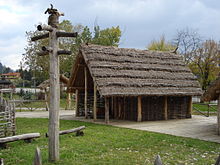
The shelter of the early people changed dramatically from the Upper Paleolithic to the Neolithic era. In the Paleolithic, people did not usually live in permanent constructions. In the Neolithic, mud brick houses started actualization that were coated with plaster.[69] The growth of agronomics made permanent houses possible. Doorways were made on the roof, with ladders positioned both on the inside and exterior of the houses.[69] The roof was supported by beams from the inside. The crude ground was covered by platforms, mats, and skins on which residents slept.[lxx] Stilt-houses settlements were common in the Alpine and Pianura Padana (Terramare) region.[71] Remains accept been found in the Ljubljana Marsh in Slovenia and at the Mondsee and Attersee lakes in Upper Republic of austria, for example.
Agriculture

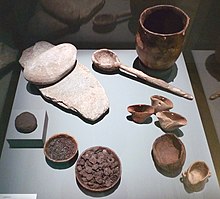
Food and cooking items retrieved at a European Neolithic site: millstones, charred breadstuff, grains and pocket-sized apples, a clay cooking pot, and containers made of antlers and wood
A pregnant and far-reaching shift in man subsistence and lifestyle was to be brought about in areas where crop farming and cultivation were get-go developed: the previous reliance on an essentially nomadic hunter-gatherer subsistence technique or pastoral transhumance was at first supplemented, then increasingly replaced past, a reliance upon the foods produced from cultivated lands. These developments are as well believed to have profoundly encouraged the growth of settlements, since it may be supposed that the increased need to spend more time and labor in tending crop fields required more localized dwellings. This trend would continue into the Statuary Age, eventually giving rise to permanently settled farming towns, and afterward cities and states whose larger populations could be sustained by the increased productivity from cultivated lands.
The profound differences in human interactions and subsistence methods associated with the onset of early agricultural practices in the Neolithic have been chosen the Neolithic Revolution, a term coined in the 1920s past the Australian archaeologist Vere Gordon Childe.
One potential benefit of the development and increasing sophistication of farming technology was the possibility of producing surplus crop yields, in other words, food supplies in excess of the immediate needs of the customs. Surpluses could exist stored for later use, or mayhap traded for other necessities or luxuries. Agricultural life afforded securities that nomadic life could not, and sedentary farming populations grew faster than nomadic.
Still, early farmers were also adversely affected in times of famine, such equally may be caused past drought or pests. In instances where agronomics had become the predominant way of life, the sensitivity to these shortages could be particularly acute, affecting agrarian populations to an extent that otherwise may not take been routinely experienced by prior hunter-gatherer communities.[62] Withal, agrarian communities generally proved successful, and their growth and the expansion of territory under cultivation connected.
Some other meaning change undergone past many of these newly agrestal communities was i of diet. Pre-agrarian diets varied past region, season, available local plant and animal resources and degree of pastoralism and hunting. Mail service-agrarian nutrition was restricted to a express packet of successfully cultivated cereal grains, plants and to a variable extent domesticated animals and creature products. Supplementation of diet by hunting and gathering was to variable degrees precluded by the increase in population above the carrying capacity of the country and a loftier sedentary local population concentration. In some cultures, there would take been a meaning shift toward increased starch and institute protein. The relative nutritional benefits and drawbacks of these dietary changes and their overall bear on on early on societal development are still debated.
In addition, increased population density, decreased population mobility, increased continuous proximity to domesticated animals, and continuous occupation of comparatively population-dense sites would have altered sanitation needs and patterns of disease.
Lithic applied science
The identifying characteristic of Neolithic technology is the use of polished or ground stone tools, in dissimilarity to the flaked rock tools used during the Paleolithic era.
Neolithic people were skilled farmers, manufacturing a range of tools necessary for the disposed, harvesting and processing of crops (such as sickle blades and grinding stones) and food production (east.g. pottery, os implements). They were also skilled manufacturers of a range of other types of stone tools and ornaments, including projectile points, beads, and statuettes. Simply what allowed wood clearance on a large scale was the polished stone axe above all other tools. Together with the adze, fashioning wood for shelter, structures and canoes for case, this enabled them to exploit their newly won farmland.
Neolithic peoples in the Levant, Anatolia, Syria, northern Mesopotamia and Fundamental Asia were also accomplished builders, utilizing mud-brick to construct houses and villages. At Çatalhöyük, houses were plastered and painted with elaborate scenes of humans and animals. In Europe, long houses built from wattle and daub were constructed. Elaborate tombs were built for the dead. These tombs are particularly numerous in Ireland, where there are many thousand still in existence. Neolithic people in the British Isles congenital long barrows and chamber tombs for their dead and causewayed camps, henges, flintstone mines and cursus monuments. It was also important to figure out means of preserving nutrient for future months, such equally fashioning relatively airtight containers, and using substances like salt as preservatives.
The peoples of the Americas and the Pacific more often than not retained the Neolithic level of tool technology until the time of European contact. Exceptions include copper hatchets and spearheads in the Great Lakes region.
Habiliment
Most clothing appears to have been made of animate being skins, as indicated past finds of large numbers of bone and antler pins that are ideal for fastening leather. Wool fabric and linen might accept become available during the later on Neolithic,[72] [73] as suggested by finds of perforated stones that (depending on size) may have served as spindle whorls or loom weights.[74] [75] [76]
Listing of early settlements

Reconstruction of a Cucuteni-Trypillian hut, in the Tripillian Museum, Ukraine

Neolithic human settlements include:
| name | location | early date (BC) | tardily date (BC) | comments |
|---|---|---|---|---|
| Tell Qaramel | Syria | 10,700[77] | 9400 | |
| Franchthi Cave | Greece | x,000 | reoccupied between 7500 and 6000 BC | |
| Göbekli Tepe | Turkey | 9600 | 8000 | |
| Nanzhuangtou | Hebei, Red china | 9500 | 9000 | |
| Byblos | Lebanon | 8800 | 7000[78] | |
| Jericho (Tell es-Sultan) | West Bank | 9500 | arising from the earlier Epipaleolithic Natufian culture | |
| Pulli settlement | Estonia | 8500 | 5000 | oldest known settlement of Kunda civilization |
| Aşıklı Höyük | Central Anatolia, Turkey, an Aceramic Neolithic menses settlement | 8200 | 7400 | correlating with the E/MPPNB in the Levant |
| Nevali Cori | Turkey | 8000 | ||
| Bhirrana | India | 7600 | 7200 | Hakra ware |
| Pengtoushan civilisation | People's republic of china | 7500 | 6100 | rice residues were carbon-14 dated to 8200–7800 BC |
| Çatalhöyük | Turkey | 7500 | 5700 | |
| Mentesh Tepe and Kamiltepe | Azerbaijan | 7000 | 3000[79] | |
| 'Ain Ghazal | Jordan | 7250 | 5000 | |
| Chogha Bonut | Islamic republic of iran | 7200 | ||
| Jhusi | India | 7100 | ||
| Motza | Israel | 7000 | ||
| Ganj Dareh | Islamic republic of iran | 7000 | ||
| Lahuradewa | India | 7000 [80] | presence of rice tillage, ceramics etc. | |
| Jiahu | Communist china | 7000 | 5800 | |
| Knossos | Crete | 7000 | ||
| Khirokitia | Cyprus | 7000 | 4000 | |
| Mehrgarh | Pakistan | 7000 | 5500 | aceramic merely elaborate civilisation including mud brick, houses, agronomics etc. |
| Sesklo | Greece | 6850 | with a 660-year margin of error | |
| Horton Plains | Sri Lanka | 6700 | cultivation of oats and barley as early on as xi,000 BC | |
| Porodin | North Macedonia | 6500[81] | ||
| Padah-Lin Caves | Burma | 6000 | ||
| Petnica | Serbia | 6000 | ||
| Stara Zagora | Bulgaria | 5500 | ||
| Cucuteni-Trypillian civilization | Ukraine, Moldova and Romania | 5500 | 2750 | |
| Tell Zeidan | northern Syria | 5500 | 4000 | |
| Tabon Cavern Complex | Quezon, Palawan, Philippines | 5000 | 2000[82] [83] | |
| Hemudu culture, large-scale rice plantation | China | 5000 | 4500 | |
| The Megalithic Temples of Malta | Malta | 3600 | ||
| Knap of Howar and Skara Brae | Orkney, Scotland | 3500 | 3100 | |
| Brú na Bóinne | Republic of ireland | 3500 | ||
| Lough Gur | Ireland | 3000 | ||
| Shengavit Settlement | Armenia | 3000 | 2200 | |
| Norte Chico civilisation, 30 aceramic Neolithic period settlements | northern coastal Peru | 3000 | 1700 | |
| Tichit Neolithic hamlet on the Tagant Plateau | central southern Mauritania | 2000 | 500 | |
| Oaxaca, state | Southwestern United mexican states | 2000 | by 2000 BC Neolithic sedentary villages had been established in the Central Valleys region of this country. | |
| Lajia | Communist china | 2000 | ||
| Mumun pottery period | Korean Peninsula | 1800 | 1500 | |
| Neolithic revolution | Japan | 500 | 300 |
The world'southward oldest known engineered roadway, the Mail Track in England, dates from 3838 BC and the earth's oldest freestanding construction is the Neolithic temple of Ġgantija in Gozo, Malta.
Listing of cultures and sites
Note: Dates are very estimate, and are only given for a rough judge; consult each civilization for specific time periods.
Early Neolithic
Periodization: The Levant: 9500–8000 BC; Europe: 5000–4000 BC; Elsewhere: varies profoundly, depending on region.
- Pre-Pottery Neolithic A (Levant, 9500–8000 BC)
- Nanzhuangtou (Red china, 8500 BC)
- Franchthi Cavern (Hellenic republic, 7000 BC)
- Cishan culture (China, 6500–5000 BC)
- Sesclo village (Greece, c. 6300 BC)
- Starcevo-Criş culture (Starčevo-Körös-Criş civilisation) (Balkans, 5800–4500 BC)
- Katundas Cavern (Republic of albania, 6th millennium BC)
- Dudeşti civilisation (Romania, 6th millennium BC)
- Beixin culture (China, 5300–4100 BC)
- Tamil Nadu culture (India, 3000–2800 BC)[84]
- Mentesh Tepe and Kamiltepe (Azerbaijan, 7000–3000 BC)[79]
Middle Neolithic
Periodization: The Levant: 8000–6000 BC; Europe: 4000–3500 BC; Elsewhere: varies greatly, depending on region.
- Pre-Pottery Neolithic B (Levant, 7600–6000 BC)
- Baodun civilisation
- Jinsha settlement and Sanxingdui mound.
- Catalhoyuk
- Cardium pottery culture
- Comb Ceramic culture
- Corded Ware culture
- Cortaillod civilisation
- Cucuteni-Trypillian culture
- Dadiwan culture
- Dawenkou culture
- Daxi culture
- Chengtoushan settlement
- Dapenkeng civilization (Taiwan, 4000-3000 BC)
- Grooved ware people
- Skara Brae, et al.
- Erlitou culture
- Xia Dynasty
- Ertebølle culture
- Hembury civilization
- Hemudu culture
- Hongshan culture
- Houli culture
- Horgen culture
- Kura–Araxes civilisation
- Liangzhu culture
- Linear Pottery culture
- Goseck circle, Circular ditches, et al.
- Longshan culture
- Majiabang culture
- Majiayao culture
- Peiligang culture
- Pengtoushan culture
- Pfyn culture
- Precucuteni culture
- Qujialing civilization
- Shijiahe culture
- Trypillian culture
- Vinča culture
- Lengyel culture (Fundamental Europe, 5000–3400 BC)
- Varna culture (S/Eastern Europe 4400–4100 BC)
- Windmill Hill civilisation
- Stonehenge
- Xinglongwa civilisation
- Beifudi site
- Xinle culture
- Yangshao culture
- Banpo and Xishuipo settlements.
- Zhaobaogou culture
Later Neolithic
Periodization: 6500–4500 BC; Europe: 3500–3000 BC; Elsewhere: varies greatly, depending on region.
- Pottery Neolithic (Fertile Crescent, 6400 – 4500 BC)
- Halaf culture (Mesopotamia, 6100 BC and 5100 BC)
- Halaf-Ubaid Transitional flow (Mesopotamia, 5500–5000 BC)
- Ubaid one/two (5400–4500 BC)
- Funnelbeaker civilization (North/Eastern Europe, 4300–2800 BC)
- Chalcolithic
Periodization: Near East: 4500–3300 BC; Europe: 3000–1700 BC; Elsewhere: varies greatly, depending on region. In the Americas, the Eneolithic concluded as late as the 19th century Advert for some peoples.
- Ubaid 3/4 (Mesopotamia, 4500–4000 BC)
- early Uruk period (Mesopotamia, 4000–3800 BC)
- middle Uruk menstruation (Mesopotamia, 3800–3400 BC)
- late Trypillian (Eastern Europe, 3000–2750 BC)
- Gaudo Civilization (Italia, 3150–2950 BC)
- Corded Ware civilization (North/Eastern Europe, 2900–2350)
- Beaker culture (Primal/Western Europe, 2900–1800 BC)
Comparative chronology
See also
- Céide Fields
- Megalith
- Neolithic decline
- Neolithic Europe
- Neolithic Revolution
- Neolithic religion
- Neolithic tomb
- Ötzi
- Paleolithic
- Stone art of the Djelfa region
- Tabon Man
- Two layer hypothesis
Notes
- ^ Some archaeologists have long advocated replacing "Neolithic" with a more descriptive term, such every bit "Early on Village Communities", just this has not gained wide acceptance.
References
Citations
- ^ Chang, M.C.: "Studies of Shang Archæology", pp. half dozen–7, 1. Yale Academy Press, 1982.
- ^ Morelle, Rebecca (21 June 2019). "former stone tools pre-appointment primeval man". South African History Online. Archived from the original on 21 June 2019.
- ^ "Neolithic". Oxford English Dictionary (Online ed.). Oxford University Press. (Subscription or participating establishment membership required.)
- ^ Diamond, J.; Bellwood, P. (2003). "Farmers and Their Languages: The First Expansions". Science. 300 (5619): 597–603. Bibcode:2003Sci...300..597D. CiteSeerX10.1.ane.1013.4523. doi:10.1126/scientific discipline.1078208. PMID 12714734. S2CID 13350469.
- ^ Habu, Junko (2004). Ancient Jomon of Japan. p. 3. ISBN978-0-521-77670-7.
- ^ Xiaohong Wu (2012). "Early Pottery at xx,000 Years Ago in Xianrendong Cave, Red china". Scientific discipline. Sciencemag.org. 336 (6089): 1696–1700. Bibcode:2012Sci...336.1696W. doi:10.1126/science.1218643. PMID 22745428. S2CID 37666548. Retrieved fifteen January 2015.
- ^ a b c d due east Bellwood 2004, p. 384.
- ^ Chacon, Richard J.; Mendoza, Rubén Thou. (2017). Banquet, Famine or Fighting?: Multiple Pathways to Social Complication. Springer. p. 120. ISBN978-3319484020.
- ^ Schmidt, Klaus (2015). Premier temple. Göbekli tepe (Le): Göbelki Tepe (in French). CNRS Editions. p. 291. ISBN978-2271081872.
- ^ Collins, Andrew (2014). Gobekli Tepe: Genesis of the Gods: The Temple of the Watchers and the Discovery of Eden. Simon and Schuster. p. 66. ISBN978-1591438359.
- ^ Scham, Sandra (November 2008). "The Earth's Starting time Temple". Archaeology. Archaeological Institute of America. 61 (6): 23.
- ^ Kislev, Mordechai Due east.; Hartmann, Anat; Bar-Yosef, Ofer (June two, 2006). "Early Domesticated Fig in the Jordan Valley". Science. American Association for the Advancement of Science. 312 (5778): 1372–1374. Bibcode:2006Sci...312.1372K. doi:10.1126/science.1125910. PMID 16741119. S2CID 42150441.
- ^ "Neolithic Age". 7 August 2015.
- ^ Feldman, Keffie. "Ain-Ghazal (Hashemite kingdom of jordan) Pre-pottery Neolithic B Flow pit of lime plaster human figures". Joukowsky Institute for Archaeology and the Ancient World. Chocolate-brown University. Retrieved March 9, 2018.
- ^ Zarins, Juris (1992) "Pastoral Nomadism in Arabia: Ethnoarchaeology and the Archaeological Tape," in Ofer Bar-Yosef and A. Khazanov, eds. "Pastoralism in the Levant"
- ^ Killebrew, Ann E.; Steiner, Margreet; Goring-Morris, A. Nigel; Belfer-Cohen, Anna (2013). "The Southern Levant (Cisjordan) During the Neolithic Menstruation". The Oxford Handbook of the Archaeology of the Levant. doi:ten.1093/oxfordhb/9780199212972.013.011. ISBN978-0199212972.
- ^ Yet another sensational discovery by polish archaeologists in Syria Archived 2011-x-01 at the Wayback Machine. eduskrypt.pl. 21 June 2006
- ^ "Jericho", Encyclopædia Britannica
- ^ Haïdar Boustani, Grand. "The Neolithic of Lebanon in the context of the Nigh Eastward: Land of knowledge" (in French), Annales d'Histoire et d'Archaeologie, Universite Saint-Joseph, Beyrouth, Vol. 12–xiii, 2001–2002. Retrieved on 2011-12-03.
- ^ Stordeur, Danielle., Abbès Frédéric., "Du PPNA au PPNB: mise en lumière d'une phase de transition à Jerf el Ahmar (Syrie)", Bulletin de la Société préhistorique française, Volume 99, Issue three, pp. 563–595, 2002
- ^ PPND – the Platform for Neolithic Radiocarbon Dates – Summary. exoriente. Retrieved on 2011-12-03.
- ^ Linseele, Five.; et al. (July 2010). "Sites with Holocene dung deposits in the Eastern Desert of Egypt: Visited by herders?" (PDF). Journal of Arid Environments. 74 (7): 818–828. Bibcode:2010JArEn..74..818L. doi:10.1016/j.jaridenv.2009.04.014.
- ^ Hays, Jeffrey (March 2011). "Early on Domesticated Animals". Facts and Details. Archived from the original on 21 October 2013. Retrieved v September 2013.
- ^ Blench, Roger; MacDonald, Kevin C (1999). The Origins and Evolution of African Livestock. Routledge. ISBN978-1-84142-018-ix.
- ^ Barker, Graeme (2009). The Agricultural Revolution in Prehistory: Why Did Foragers Become Farmers?. Oxford University Press. pp. 292–293. ISBN978-0-19-955995-four . Retrieved iii December 2011.
- ^ Alexandra Y. Aĭkhenvalʹd; Robert Malcolm Ward Dixon (2006). Areal Diffussion and Genetic Inheritance: Problems in Comparative Linguistics. Oxford University Press, The states. p. 35. ISBN978-0-xix-928308-8.
- ^ Fekri A. Hassan (2002). Droughts, food and civilisation: ecological change and nutrient security in Africa's afterward prehistory. Springer. pp. 164–. ISBN978-0-306-46755-iv . Retrieved iii Dec 2011.
- ^ Shillington, Kevin (2005). Encyclopedia of African history: A–G. CRC Press. pp. 521–. ISBN978-1-57958-245-half-dozen . Retrieved 3 December 2011.
- ^ Marshall, Fiona; Hildebrand, Elisabeth (2002-06-01). "Cattle Before Crops: The Beginnings of Food Production in Africa". Periodical of Earth Prehistory. sixteen (2): 99–143. doi:x.1023/A:1019954903395. ISSN 0892-7537. S2CID 19466568.
- ^ Garcea, Elena A. A. (2004-06-01). "An Alternative Way Towards Food Production: The Perspective from the Libyan Sahara". Journal of Earth Prehistory. 18 (2): 107–154. doi:ten.1007/s10963-004-2878-6. ISSN 0892-7537. S2CID 162218030.
- ^ Gallinaro, Marina; Lernia, Savino di (2018-01-25). "Trapping or tethering stones (TS): A multifunctional device in the Pastoral Neolithic of the Sahara". PLOS I. 13 (1): e0191765. Bibcode:2018PLoSO..1391765G. doi:ten.1371/periodical.pone.0191765. PMC5784975. PMID 29370242.
- ^ Bower, John (1991-03-01). "The Pastoral Neolithic of East Africa". Journal of World Prehistory. five (ane): 49–82. doi:10.1007/BF00974732. ISSN 0892-7537. S2CID 162352311.
- ^ Ambrose, Stanley H. (1984). From Hunters to Farmers: The Causes and Consequences of Food Product in Africa – "The Introduction of Pastoral Adaptations to the Highlands of Due east Africa". University of California Printing. p. 220. ISBN978-0520045743 . Retrieved 4 December 2014.
- ^ Dawn Fuller (Apr 16, 2012). "UC research reveals 1 of the earliest farming sites in Europe". Phys.org . Retrieved April eighteen, 2012.
- ^ "1 of Primeval Farming Sites in Europe Discovered". ScienceDaily. April xvi, 2012. Retrieved April xviii, 2012.
- ^ Female figurine, c. 6000 BC, Nea Nikomidia, Republic of macedonia, Veroia, (Archaeological Museum), Greece. Macedonian-heritage.gr. Retrieved on 2011-12-03.
- ^ Winn, Shan (1981). Pre-writing in Southeastern Europe: The Sign System of the Vinča Civilisation ca. 4000 BC. Calgary: Western Publishers.
- ^ Daniel Cilia, "Malta Before Common Era", in The Megalithic Temples of Malta. Retrieved 28 January 2007.
- ^ Piccolo, Salvatore (2013) Aboriginal Stones: The Prehistoric Dolmens of Sicily, Abingdon-on-Thames, England: Brazen Head Publishing, pp. 33–34 ISBN 978-0-9565106-ii-iv
- ^ Coningham, Robin; Young, Ruth (2015), The Archeology of South asia: From the Indus to Asoka, c. 6500 BCE – 200 CE, Cambridge University Printing Quote: ""Mehrgarh remains one of the primal sites in South Asia because it has provided the earliest known undisputed show for farming and pastoral communities in the region, and its institute and beast textile provide clear prove for the ongoing manipulation, and domestication, of certain species. Mayhap most chiefly in a South Asian context, the function played by zebu makes this a distinctive, localised evolution, with a character completely unlike to other parts of the globe. Finally, the longevity of the site, and its articulation with the neighbouring site of Nausharo (c. 2800–2000 BC), provides a very clear continuity from South Asia'southward showtime farming villages to the emergence of its outset cities (Jarrige, 1984)."
- ^ Fisher, Michael H. (2018), An Environmental History of India: From Earliest Times to the Twenty-Offset Century, Cambridge Academy Press, ISBN978-1-107-11162-ii Quote: "page 33: "The primeval discovered instance in India of well-established, settled agricultural society is at Mehrgarh in the hills between the Bolan Pass and the Indus plain (today in Islamic republic of pakistan) (encounter Map iii.1). From as early on every bit 7000 BC, communities there started investing increased labor in preparing the land and selecting, planting, disposed, and harvesting particular grain-producing plants. They also domesticated animals, including sheep, goats, pigs, and oxen (both humped zebu [Bos indicus] and unhumped [Bos taurus]). Castrating oxen, for instance, turned them from mainly meat sources into domesticated typhoon-animals as well."
- ^ Dyson, Tim (2018), A Population History of India: From the Kickoff Modern People to the Present Day, Oxford University Press, ISBN978-0-nineteen-882905-eight , Quote: "(p 29) "The subcontinent's people were hunter-gatherers for many millennia. In that location were very few of them. Indeed, 10,000 years ago there may only have been a couple of hundred grand people, living in small, frequently isolated groups, the descendants of various 'modernistic' human incomers. So, perhaps linked to events in Mesopotamia, almost 8,500 years agone agronomics emerged in Baluchistan."
- ^ Wright, Rita P. (2009), The Ancient Indus: Urbanism, Economy, and Society, Cambridge Academy Press, pp. 44, 51, ISBN978-0-521-57652-ix
- ^ Coppa, A.; Bondioli, L.; Cucina, A.; Frayer, D. West.; Jarrige, C.; Jarrige, J. -F.; Quivron, Thousand.; Rossi, M.; Vidale, M.; Macchiarelli, R. (2006). "Early Neolithic tradition of dentistry". Nature. 440 (7085): 755–756. Bibcode:2006Natur.440..755C. doi:10.1038/440755a. ISSN 0028-0836. PMID 16598247. S2CID 6787162.
- ^ Eleni Asouti and Dorian Q Fuller (2007). Trees and Woodlands of Due south India: Archaeological Perspectives.
- ^ Xiaoyan Yang (2012). "Early millet utilise in northern China". Proceedings of the National University of Sciences. 109 (x): 3726–3730. Bibcode:2012PNAS..109.3726Y. doi:10.1073/pnas.1115430109. PMC3309722. PMID 22355109.
- ^ "New Archaeological Discoveries and Researches in 2004 – The Fourth Archeology Forum of CASS". Establish of Archaeology, Chinese University of Social Sciences. Apr 28, 2005. Retrieved September 18, 2007.
- ^ The Archæology News Network. 2012. "Neolithic subcontract field found in South korea".
- ^ The Korea Times (2012). "East Asia's oldest remains of agricultural field found in Korea".
- ^ Willey, Gordon R.; Phillips, Philip (1957). Method and Theory in American Archaeology. University of Chicago Press. ISBN978-0-226-89888-9.
- ^ Kohler TA, M Glaude, JP Bocquet-Appel and Brian M Kemp (2008). "The Neolithic Demographic Transition in the Due north American Southwest". American Artifact. 73 (4): 645–669. doi:x.1017/s000273160004734x. hdl:2376/5746. S2CID 163007590.
{{cite journal}}: CS1 maint: uses authors parameter (link) - ^ A. Eichler, M. Gramlich, T. Kellerhals, Fifty. Tobler, Thursday. Rehren & M. Schwikowski (2017). "Water ice-core evidence of primeval extensive copper metallurgy in the Andes 2700 years ago"
- ^ White, Peter, "Revisiting the 'Neolithic Problem' in Australia" PDF, 2006
- ^ a b Leonard D. Katz Rigby; S. Stephen Henry Rigby (2000). Evolutionary Origins of Morality: Cross-disciplinary Perspectives. United Kingdom: Imprint Academic. p. 158. ISBN0-7190-5612-8.
- ^ Langer, Jonas; Killen, Melanie (1998). Piaget, evolution, and development. Psychology Printing. pp. 258–. ISBN978-0-8058-2210-half-dozen . Retrieved three December 2011.
- ^ "The Oldest Culture in the Americas Revealed" (PDF). CharlesMann. Science. Archived from the original (PDF) on ten October 2015. Retrieved 9 Oct 2015.
- ^ "First Andes Civilization Explored". BBC News. 22 December 2004. Retrieved 9 October 2015.
- ^ Hommon, Robert J. (2013). The ancient Hawaiian country: origins of a political gild (First ed.). New York: Oxford University Press. ISBN978-0-xix-991612-2.
- ^ "Stone Age," Microsoft Encarta Online Encyclopedia 2007 © 1997–2007 Microsoft Corporation. All Rights Reserved. Contributed by Kathy Schick, B.A., Yard.A., Ph.D. and Nicholas Toth, B.A., M.A., Ph.D. Archived 2009-11-01.
- ^ a b Russell Dale Guthrie (2005). The nature of Paleolithic fine art. University of Chicago Press. pp. 420–. ISBN978-0-226-31126-5 . Retrieved iii December 2011.
- ^ "Farming Pioneered in Aboriginal New Republic of guinea". New Scientist. New Scientist. Retrieved 9 October 2015.
- ^ a b Bahn, Paul (1996) "The atlas of world archaeology" Copyright 2000 The brown Reference Grouping plc
- ^ "Prehistoric Cultures". Museum of Aboriginal and Modern Art. 2010. Retrieved v September 2013.
- ^ Hirst, G. Kris. "Çatalhöyük: Urban Life in Neolithic Anatolia". Near.com Archæology. Well-nigh.com. Retrieved 5 September 2013.
- ^ Idyllic Theory of Goddess Creates Storm Archived 2008-02-19 at the Wayback Machine. Holysmoke.org. Retrieved on 2011-12-03.
- ^ Krause (1998) under External links, places.
- ^ Gimbutas (1991) page 143.
- ^ Kuijt, Ian (2000). Life in Neolithic farming communities: social organization, identity, and differentiation. Springer. pp. 317–. ISBN978-0-306-46122-4 . Retrieved 3 December 2011.
- ^ a b Shane, Orrin C. III, and Mine Küçuk. "The World'southward Beginning Urban center." Archived 2008-03-xv at the Wayback Machine Archaeology 51.2 (1998): 43–47.
- ^ Barber, E. J. W. (1991). Prehistoric Textiles:The Development of Cloth in the Neolithic and Bronze Ages with Special Reference to the Aegean. Princeton University Printing. ISBN978-0-691-00224-8.
- ^ Alan W. Ertl (2008). Toward an Understanding of Europe: A Political Economical Précis of Continental Integration. Universal-Publishers. p. 308. ISBN978-1-59942-983-0 . Retrieved 28 March 2011.
- ^ Harris, Susanna (2009). "Smooth and Cool, or Warm and Soft: Investigating the Properties of Cloth in Prehistory". North European Symposium for Archaeological Textiles 10. Academia.edu. Retrieved v September 2013.
- ^ "Aspects of Life During the Neolithic Flow" (PDF). Teachers' Curriculum Institute. Archived from the original (PDF) on 5 May 2016. Retrieved five September 2013.
- ^ Gibbs, Kevin T. (2006). "Pierced dirt disks and Late Neolithic textile production". Proceedings of the fifth International Congress on the Archaeology of the Aboriginal Near East. Academia.org. Retrieved five September 2013.
- ^ Dark-green, Jean M (1993). "Unraveling the Enigma of the Bi: The Spindle Whorl equally the Model of the Ritual Disk". Asian Perspectives. University of Hawai'i Press. 32 (i): 105–24. hdl:10125/17022.
- ^ Cook, Grand (2007). "The clay loom weight, in: Early Neolithic ritual action, Statuary Age occupation and medieval activity at Pitlethie Road, Leuchars, Fife". Tayside and Fife Archaeological Periodical. 13: 1–23.
- ^ Mazurowski, Ryszard F.; Kanjou, Youssef, eds. (2012). Tell Qaramel 1999-2007. Protoneolithic and early Pre-Pottery Neolithic settlement in Northern Syria. PCMA Excavation Serial 2. Warsaw, Poland: Smoothen Heart of Mediterranean Archaeology, University of Warsaw. ISBN978-83-903796-three-0.
- ^ East. J. Peltenburg; Alexander Wasse; Quango for British Research in the Levant (2004). Garfinkel, Yosef., "Néolithique" and "Énéolithique" Byblos in Southern Levantine Context in Neolithic revolution: new perspectives on southwest Asia in low-cal of recent discoveries on Republic of cyprus. Oxbow Books. ISBN978-i-84217-132-5 . Retrieved 18 January 2012.
- ^ a b Ostaptchouk, Dr. "Contribution of FTIR to the Characterization of the Raw Cloth for "Flint" Chipped Stone and for Chaplet from Mentesh Tepe and Kamiltepe (Azerbaijan). Preliminary Results".
- ^ Davis K. Thanjan (12 January 2011). Pebbles. Bookstand Publishing. pp. 31–. ISBN978-i-58909-817-6 . Retrieved 4 July 2011.
- ^ Developed Neolithic period, 5500 BC Archived 2011-03-11 at the Wayback Machine. Eliznik.org.uk. Retrieved on 2011-12-03.
- ^ "Manunggul Burial Jar". Virtual Collection of Asian Masterpieces . Retrieved 5 September 2013.
- ^ "Tabon Cave Complex". National Museum of the Philippines. 2011. Archived from the original on 25 Feb 2021. Retrieved 5 September 2013.
- ^ "Neolithic Culture of Tamil Nadu: an Overview" (PDF).
Sources
- Bellwood, Peter (Nov thirty, 2004). Start Farmers: The Origins of Agricultural Societies. Wiley-Blackwell. p. 384. ISBN978-0-631-20566-1.
- Pedersen, Hilthart (2008). Die Jüngere Steinzeit Auf Bornholm. Smiling Verlag. ISBN978-three-638-94559-2.
External links
| | Wikiquote has quotations related to: Neolithic |
- Romeo, Nick (Feb. 2015). Embracing Stone Age Couple Found in Greek Cave. "Rare double burials discovered at one of the largest Neolithic burial sites in Europe." National Geographic Social club
- McNamara, John (2005). "Neolithic Period". World Museum of Homo. Archived from the original on 2008-04-thirty. Retrieved 2008-04-14 .
- Affonso, T.; Pernicka, E. (2000). "Pre-Pottery Neolithic Clay Figurines from Nevali Çori". Internet Archaeology (9). doi:ten.11141/ia.nine.4.
- Rincon, Paul (11 May 2006). "Brutal lives of Stone Age Britons". BBC News . Retrieved 2008-04-xiv .
- Current Directions in W African Prehistory – McIntosh & McIntosh (1983)
- . Encyclopædia Britannica (11th ed.). 1911.
Source: https://en.wikipedia.org/wiki/Neolithic